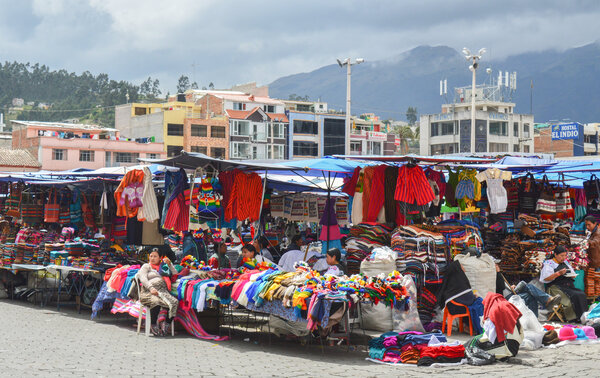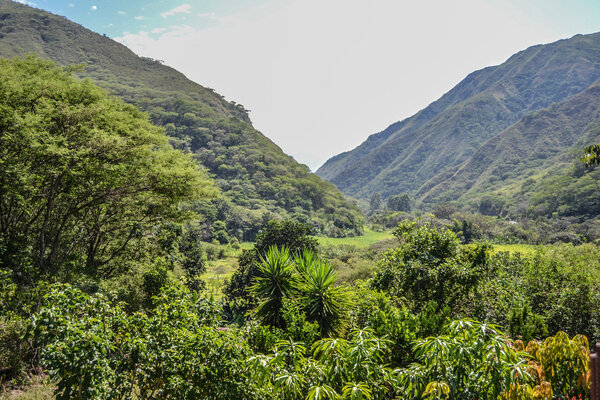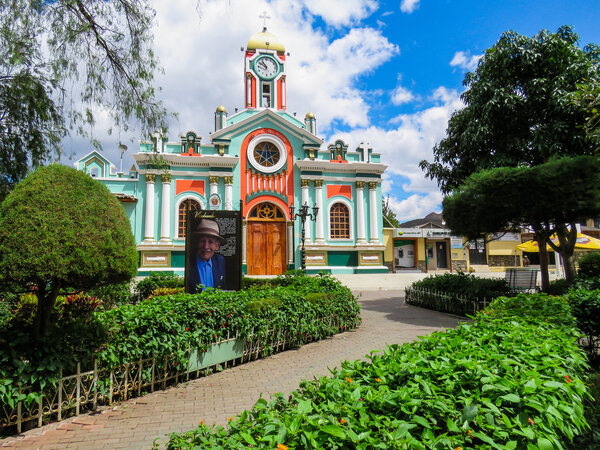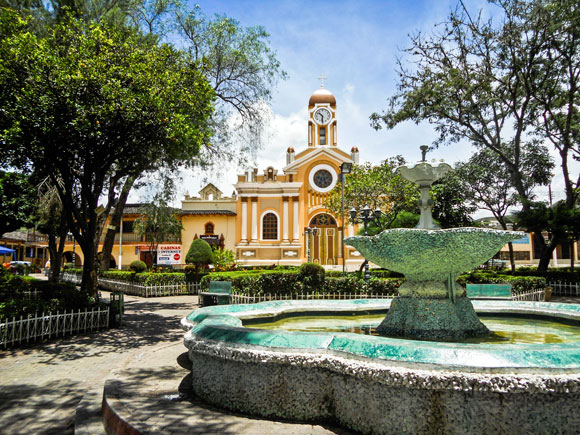By IL‘s Ecuador Insider, Donna Stiteler, and Guest Contributor, Brian Sullivan
Finding Hidden Gems on a Day Out in Ecuador
By Brian Sullivan
Ecuador is a country full of gems just waiting to be discovered and shared. Whether you’re exploring on foot, by bus, by car, or by bicycle, you can never be sure what exciting or historic thing you may suddenly tumble upon.
Ecuador’s towns are each unique, and usually offer their own specific local speciality. For example, Cotacachi is known for its leather goods, Ibarra for its ice cream, Cayambe for its biscochos, Otavalo for its huge artisanal market, and Illumán for its hand-made sombreros, just to name a few.
Less-well-known finds are also plentiful—and make exploring this country even more fun.

My wife, Janette, and I have lived in Cotacachi for seven years. We’ve had great adventures throughout Ecuador—including many close to home.
I have purchased three bicycles since moving here, and I try to cycle, on average, 1,000 kilometers (over 600 miles) per year, riding mainly in the nearby Imbabura mountains.
This takes me and my friends down dirt roads, across ravines, on highways, over bridges, and even sometimes…well…onto a racetrack!
While out with a buddy just north of Ibarra, at Lago Yahuarcocha, we were riding around the lake on a nicely paved bicycle path. It leads uphill to an international race-car track that attracts drivers from around South America, who race professionally here on select weekends.
That morning, we stopped to have a closer look at the track, and drove up to the front gate, which is also part of an attached local fire department. After a quick chat with a firefighter, we were invited to ride our bikes on the racetrack. Of course, we accepted the offer, and within minutes we were riding on the track, where we encountered a few more cyclists and some runners.
After further investigation, it turned out that the track is open to walkers, runners, and cyclists every weekday morning from 6 a.m. to 8 a.m.
It was a total hoot ripping around this track, and then pulling into the pitstop for a water break and some picture taking. Who would have thought that such a gem was tucked away just outside Ibarra and open to the public?
I go back there regularly, often bringing new riders to check it out as well.
Another nearby treasure is located on a cliff between the city of Otavalo and the small town of San José de Quichinche.
I was out on a Sunday with friends. Since it was a clear and sunny day, I decided to drive up to the top of the hills surrounding Otavalo to get some nice photos.
While exploring, I ended up on a dirt road that was leading nowhere, so I turned around. As I did, I suddenly spotted the tail of an aircraft in a field.
I pulled my truck over and climbed up on the running boards for a better look. What a surprise! There was a fully intact 1950s jet airliner parked in a field at a private hacienda.
I was able to get some great pics, did a bit of research, and eventually met the owner—who gave me a private tour of this French SE 210 Caravelle.
This was my best find yet. What a hidden gem!
On another trip, this time to the Quilotoa area, Janette and I were walking around the beautiful city of Latacunga, looking for a place to have a cocktail.
We saw a weird sign that read “El Gringo y La Gorda” (The Gringo and the Fat Lady). We had to check it out. In the lobby floor of what looked like an old Spanish hotel, there was a New Orleans-style restaurant with po-boys on the menu and 2-for-1 specials on cocktails.
We had a few drinks, which then turned into supper and more drinks. We were approached by the Ecuadorian owner, who told us that he had worked for the world-renowned chef Emeril Lagasse as his executive chef in New Orleans. After Hurricane Katrina hit, the restaurant was forced to close and he returned to Ecuador, opening this excellent place in Latacunga.
The food was great, the decor and vibe phenomenal, and the drinks cheap.
A bit of exploration, some good timing, and yet another awesome find.
In my experience, the best discoveries in Ecuador are made with little or no prior research…
Don’t get me wrong—planning a good trip is safe, smart, and ensures that you don’t miss out.
All I’m saying is that sometimes, on the spur of the moment…getting out on foot, on a bike, or on a bus…and heading to explore the small or large towns of Ecuador, you may be surprised at what hidden gems you find.
Happy hunting!
Is Vilcabamba Really a Hippy Paradise? I Went to Find Out
By Donna Stiteler

I first became intrigued with Vilcabamba after watching a documentary about the “Valley of Longevity,” where indigenous people live to be 100. I wanted to visit this place where health is at the forefront and relaxation is the mantra.
The town of Vilcabamba—south from my home base of Cuenca—is surrounded by towering mountains and leafy woods, attracting backpackers and birdwatchers. The Podocarpus National Park is just up the road, where you may see bears, wild cats, and definitely numerous bird species.
Hippies flock to Vilcabamba, wearing weathered t-shirts and worn sandals, seeking to reclaim their Woodstock days. I’d heard that expats hang at tables outside of bars, discussing philosophy and drinking beers, getting high on life. I’d heard that when you walk around Vilcabamba’s downtown, the smell of pot lingers in the air. (With only a few policemen in Vilcabamba, there’s little chance of getting arrested. Besides, you can legally carry up to 10 grams of cannabis, so a couple of joints won’t get you in trouble anyway.) When I arrived, I wondered if the police smoke too, as everyone here seems mellow.
Vilcabamba is where you go to escape from worries. I’d heard that you can feel your stress start to fade as soon as you land in town.
So, I wanted to check it out. To see if the rumors of centenarians and stoned expats were true.
Vilcabamba is a small town of 4,000, including 100 or so expats. Beer-infused tourists come to enjoy mid-70s F weather and the plethora of health spas just outside of town.
I haven’t ventured out during the pandemic, except to go to the grocery store or to have a mask-wearing, socially distanced lunch with friends. I follow the rules, which are strict in Ecuador and come with stiff fines if you don’t comply.
When my friend Sandy suggested a trip to Vilcabamba, I decided to exit my cocoon and go to write a story. Armed with innate curiosity, a spray bottle of alcohol, Lysol wipes, goggles, a packet of masks, plastic gloves, and a gaiter (which doesn’t necessary protect you, but adds a fashion statement), I headed off for the four-and-a-half-hour bus ride.
If you think I’m over-cautious about the pandemic, it’s nothing compared to Sandy. She toyed with the idea of wearing a full plastic body suit on our bus ride, but changed her mind when she figured she’d more likely die of heat stroke than the virus. Instead, she opted for layers of clothes she could peel off and shred after the trip. She carried everything I did but added some DEET spray in case of killer bugs, sun repellent for her fair skin, and a rasher of fear.
The spa we were going to contracted a van with a superb company schooled in the ways of coronavirus safety and certified to travel between towns. Sandy was scared people wouldn’t wear their masks, so we were both relieved when everyone complied. If someone coughed, Sandy would draw her alcohol spray like a gunslinger and fill the air with virus-killing potions. No one talked on the bus—very rare for a group of expats, who usually talk endlessly. It was quiet—a good beginning to our tranquillo trip.
People were socially distanced on the 15-seat bus—with only six passengers allowed aboard. We whirled around the Cajas mountains, with views of valleys and clouds at eye level. As we weaved through mountain towns, we saw women pulling cows on long ropes to graze in nearby fields. And lots of horses, cows, goats, lambs, and the occasional llama. We are were only stopped once by police, who checked our driver’s credentials and then waved us through.
We passed through Saraguro, an Andean village where tribal natives have retained much of their land, culture, and traditional dress. The tribal members wear black, with women clad in long dark dresses with brightly colored weaved belts. The men wear black clothes topped with a black and white cow-spotted sombrero. They don’t cut their hair, instead wearing their long locks in ponytails that reach their waists. Saraguro is known for great cheese and the Michelin Star-quality restaurant, Shamuico Espai Gastronomic, where the full experience includes six scrumptious courses.
So, the ride was painless for the most part, albeit a little longer than anticipated. By the time we got off at the Izhcayluma Hosteria and Spa, we were already hungry and tired.
The spa owner met us at the van and walked us to our cabin. He had arranged for us to get a cabin with great views of the Andes and a porch the size of most people’s living rooms. The porch was stocked with brightly colored hammocks, a picnic table, and comfy chairs that reclined.
Exhausted but ravenous, we headed out immediately to catch dinner at the open-air café, where we found other folks we knew from Cuenca. Like us, they had traveled to get away from the bustle of a big city. The food offered at the spa included pastas, pizzas, roast pork, and chicken entrees enveloped in creamy sauces of our choice. There were also home-made brews and wine. The helpings put North American-sized entrees to shame and could have easily fed two people. We settled in at a table overlooking the mountains and stuffed ourselves like it was our last meal, gossiping with a few of our Cuenca neighbors. We carried a glass of wine and some mineral water (tapped from nearby springs) up to our cabin, where we stretched out on lawn chairs and savored the incredible views.
A complaining donkey in the valley shouted his discontent as we gazed at the clear night sky dotted with hundreds of stars. And we laughed that the donkey was the only thing that wasn’t mellow in Vilcabamba. We chatted a bit before turning in. Our private rooms were next to each other, both with large walk-in showers, soft beds with white fluffy comforters, and windows through which we could see the full moon.
The next morning, we decided to go into the town itself, a 30-minute walk downhill through back roads where we passed the concrete-block, tin-roofed homes of the indigenous. Their large gardens sported white corn, cabbage, carrots, and potatoes. I kept looking for indigenous centenarians, but no one looked old, at least not 100 years old.

When we reached Centro (downtown), we found only a small town square. There was nothing particularly outstanding about it—except its vibe. Health shops, ice cream parlors, and bars lined the square, so you could indulge in all types of vices. Wellness stores offered alternative medicines and $20 massages. Expats were sitting at tables in front of the bars, drinking pilsners. But I didn’t see stoners lurking… It was Sunday—so maybe they were in church.
I did notice the familiar smell of pot as we walked around the square…but there wasn’t a preponderance of it. And for the record, I still didn’t see any centenarians…but I heard a rumor that they all live in a small community outside of town.
It only takes about an hour to see all of downtown Vilcabamba, and that’s if you dally. It’s not the town you go to see. It’s the ambiance you go to enjoy. It certainly had the laidback vibe it’s famous for and that tourists seek.
All the resort spas in Vilcabamba offer pedicures, manicures, and massages ranging from relaxing to bruise-giving. Spas offer free yoga classes and grow most of their own vegetables, which they serve for dinner in outdoor settings. The stated goal is to create a place where nature flourishes as well as people.
Back at the resort, we had scheduled massages for the afternoon, and took turns getting kneaded by indigenous women. It felt so good I scheduled another massage for the next day, plus a pedicure. I was all-in on comfort.
Sandy and I stuffed ourselves again at breakfast (which was included). And at dinner, we ate ourselves into a coma, asleep by nightfall. During the day, we hung out (literally and figuratively) in the hammocks, once we figured out how to get into them. I felt like a swaddled baby! When it was time to get out, we figured it’d take the jaws of life to dislodge us. But we managed.
One the second day, we went on a moderate hike up a mountain to view the town from above, and to look for that settlement of centenarians. We didn’t see any person aged 100, but we did spot hundreds of birds.
The mountain climb was steeper than I thought. Sandy skipped easily up the trails… I chased her saying if I caught her, I would kill her—since it was her idea to take the longer trail. At the top, there was an overlook and a bench, where we rested before starting back down. The entire hike was only an hour, but we sweated and panted our way down the trail and completing it gave us a sense of accomplishment. Thank God the trail ended at the spa—where I knew a massage waited for me.
After the hike, we settled into a late breakfast, chowing down on fresh baked bread, scrambled eggs, bacon, and fruit juice. Then it was back to our porch to reclaim our hammocks and read until it was time for me to go get my second massage and pedicure; while I was at this, Sandy took a dip in the chilly pool.
This was just the break we needed. With no television to remind us of corona statistics, or political mayhem, and birds singing to us all day, it was nothing short of, well, relaxing.
It was a reminder that life goes on—and goes even better when someone is robustly rubbing your back.


